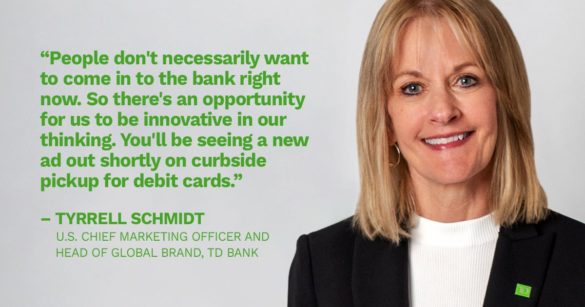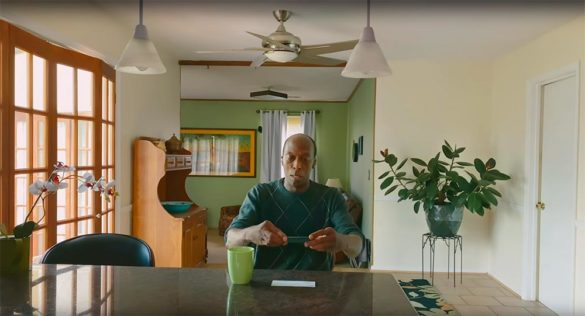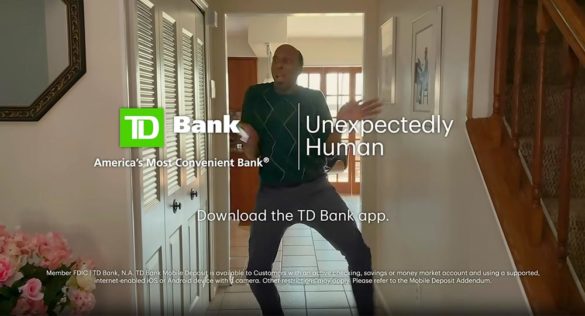Tyrrell Schmidt brings experience to the COVID-19 pandemic that most American financial institution marketers haven’t had. She’s run a banking operation in the midst of pandemic before, specifically the SARS outbreak that began in Asia and ran from 2002 to 2004.
Schmidt, named to be U.S. Chief Marketing Officer and Head of Global Brand at TD Bank during the summer of 2020, is a 35-year veteran of financial marketing. At the time of the SARS outbreak, she served as General Manager, Credit Cards and Personal Loans, at Standard Chartered Bank in Hong Kong. She navigated both the impact of the disease on the market as well as its serious effects on the economy there. The disease put the brakes on a recovery.
“What we are going through globally currently is unprecedented,” says Schmidt, who joined TD in 2015, most recently working as Vice President and Global Brand and Customer Experience Officer in Toronto. “However, there are similarities.”
Elaborating, Schmidt says that both the SARS economy and today’s COVID-19 recession present banking institutions with the opportunity to “help people get back on their feet, financially. It’s really important to understand customers’ realities, both through data analytics and through one-on-one relationships that bankers develop with those customers.”
While the current coronavirus pandemic has expanded far beyond the spread of SARS (estimated at roughly 8,000 worldwide), and the pace of everything moves more quickly now, Schmidt says that at the core of the challenge for financial institutions and specifically for financial marketers is the stress on customer centricity.
“There has definitely been an increase in the financially vulnerable population,” says Schmidt. The scale of consumers impacted in various ways economically and the damage to small businesses haven’t been seen for decades. Both groups have been looking to financial providers like TD Bank for help and advice on how to get through current financial conditions. On the other hand, some investors and others have benefited economically in this period — think of the boom just in masks and hand sanitizer — and they also have financial questions and needs tied to pandemic conditions.
“So we need to be there with all of our customers on their journey given their own current reality,” she says.

Move the Needle from Attrition to Acquisition
Vericast’s 2024 Financial TrendWatch explores seven of today’s most critical financial services trends to provide a complete view of the current loyalty landscape.
Read More about Move the Needle from Attrition to Acquisition

Navigating Credit Card Issuing in an Uncertain Economic Environment
Build a modern credit card strategy that balances profitability and risk, adopts the latest technology and delivers the customization that cardholders demand.
Read More about Navigating Credit Card Issuing in an Uncertain Economic Environment
Moving Past the Early Days to Reopening Time
TD Bank pushed to participate in the Paycheck Protection Program and through a gamut of consumer and small business aid programs under the name TD Cares. Getting the word out on that, and on COVID in general, early on, was critical. (Nearly a quarter of a million people enrolled in TD Bank relief programs in the U.S. early on, with four out of five exiting the programs later.) But going forward, says Schmidt, the tone in bank marketing messaging must be carefully crafted.
“You have to use insights to understand what people want to hear and what they consider relevant right now,” says Schmidt. Doing this well can differentiate a financial institution even now that society is struggling to achieve the proverbial “new normal.”
“Generally, people are looking for more optimism today. In the face of everything people are confronting today, we think our brand, built around ‘Unexpectedly Human,” really resonates right now,” says Schmidt. “That’s really what we try to do, give customers what they need and want, but in ways that are unexpectedly human and that give a little bit of a jolt of joy. Optimism, balanced with realism, is really important right now.”
In the course of bringing consumers and business customers aid and advice, says Schmidt, “Job 1” consists of maintaining focus, in a distracting time, on the bank’s key constituencies.
“I would say we’ve doubled down there,” she says. One fresh effort amid the industry’s stress on contactless banking is a twist on the curbside delivery that many retailers adopted during COVID.
“People don’t necessarily want to come in to the bank right now,” says Schmidt. Indeed, in the late September 2020 edition of the J.D. Power COVID-9 Pulse Survey, while 54% of the sample had used their bank’s mobile app in the past week and 34% had used online banking, only 15% had conducted a teller transaction in a branch. Many of TD Bank’s ubiquitous branches have drive-through lanes and this helped it serve many consumers where branch lobbies couldn’t accommodate them due to closures.
“So there’s an opportunity for us to be innovative in our thinking,” she continues. “You’ll be seeing a new ad out shortly on curbside pickup for debit cards,” for example.
TD Bank has seen its own share of the digital acceleration many banks and credit unions have. Schmidt says the bank’s research indicates that many people who made their first use of digital channel will stick once the COVID environment passes. 20% of the J.D. Power sampling said they will visit branches less than pre-crisis.
Schmidt sees the increasingly digital face of TD as an evolution, albeit faster than expected, of the TD Bank registered slogan, “America’s Most Convenient Bank.” While that historically meant seven-days-a-week branch banking, going back to the days of predecessor Commerce Bank, it will increasingly mean digital convenience.
Read More:
- How Ex-Umpqua Marketing Exec Will Shake Up Branding at BBVA Simple
- Ally CMO Andrea Brimmer to Banks: ‘It’s Time to Get Rolling Again!’
- Wells Fargo Retail Chief Mary Mack Says COVID Won’t Kill Branches
- Meet Citi’s Next CEO Jane Fraser: How She Climbed to the Top in Banking
Learning Agility against the COVID Backdrop
The coronavirus turned up the speed at which just about everything in marketing had to be done.
“All marketers these days are juggling a lot of different new aspects of change that a year ago didn’t seem like something that we’d be thinking about,” says Schmidt. When she stepped into her new job in early September the pace picked up, but Schmidt had already been working in a whirlwind from the early days of the coronavirus. An early challenge was getting the TD marketing function into work-from-home mode on laptops — shifting roughly 700 people into a new way of handling marketing work.
But Schmidt says things like that and the ramp up of the PPP effort will likely be a preview of what bank marketing life will be going forward. Learning adaptability and agility will just be part of the job description. COVID is an overlay on Schmidt’s central task of “driving growth, by outperforming competitors and being recognized as a financial leader.” Schmidt believes adding more marketing to the digital channels will be critical through the rest of the COVID period and beyond.
As an example of agility in marketing, Schmidt points to a gearshift made in a commercial that was airing pre-COVID, and its COVID reimagining.
In the original, a TD Bank banker is working alone in a branch, after hours, waiting for a customer who needs special assistance. Music on the P.A. system gives him the irresistible urge to dance to it on the bank’s lobby floor. He goes for it. Then the customer, seeing the dancing banker, knocks on the glass door. The banker straightens up and lets him in. This human foible goes with the “Unexpected Human” tagline.
Back in May 2020, when the pandemic was only a few months old, management realized that it needed to deliver the message that digital banking would meet all of consumers’ immediate banking needs.
“We needed people to bank from home for their own safety,” says Schmidt. “So we found the same dancer and we had him do a reshoot.” The spot shows the dancer, played by actor Julian Rozzell Jr., as the same banker. He is at home, self-isolating. He is using mobile deposit at his kitchen table, and then hears the same song in his home kitchen. He succumbs to the temptation to dance again and the spot closes urging people to use digital services during COVID.
“We pivoted the original message, leveraging something that was working really well,” says Schmidt. Given the need to socially distance, however, a full film crew was out of the question.
“So we shot it using an iPhone 11,” Schmidt explains. This simple illustration suggests more significant adaptations marketers may need to make further down the road, she suggests.
Here’s the takeaway for other marketers. “We have had to find ways to do things differently and get things into the market faster than ever before,” says Schmidt. “We’re no longer going to have campaigns that take sixth months from briefing to concept to getting them into the market. Necessity is the mother of innovation.

Looking Beyond COVID Effects at Marketing’s Broader Evolution
With her new job, Schmidt has been learning more about marketing technology, or martech. She’s been delving into the bank’s martech stack. There’s still much that can be applied that isn’t yet being applied, she believes.
One advantage she says she has is the technology of Layer 6. This is a Canadian artificial intelligence firm that TD Bank Group, the bank’s parent, acquired in 2018. The firm specializes in applications that enable greater personalization.
Being able to use AI to produce tailored messaging right down to the individual level excites Schmidt.
“There’s just so much there. I love technology that allows you to adapt your headline, your creative, your message, your call to action, your offer like that,” says Schmidt. “It should be very relevant and meaningful for the customer.”
However, Schmidt resists the idea of completely turning marketing communication over to AI.
“We’re in a highly regulated industry, with risk management and compliance concerns,” says Schmidt. “You can let the AI generate many different permutations and combinations to allow messages to be more personalized. But some human element that goes into the process will be important to us. And it will be interesting to see what people respond to, and why.”













